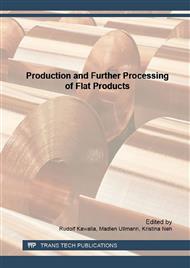p.99
p.106
p.112
p.118
p.124
p.133
p.140
p.146
p.152
Effects of Process Parameter Variation on the Bonding Strength in Clad Steel Strips by Twin-Roll Strip Casting
Abstract:
Twin-roll strip casting represents a promising alternative production route for clad steel strips. The main idea behind the presented research is the introduction of a prefabricated strip into the melt pool of a twin-roll casting process to exploit the heat of the melt to create bonding between the cast strip and the prefabricated strip. Prior investigations proved the general feasibility of this concept for steel-steel combinations and described the bonding of the two layers. This concept is now further investigated with the aim to understand the influence of the process parameters on the bonding. For the experiments an austenitic high manganese steel is cladded with an austenitic stainless steel. Beginning from a starting point determined in numerical simulations, a process window for the introduction of a 0.3 mm thick strip of 1.4301 was identified by process parameter variation during casting experiments. Up to 25 m long clad strips with a thickness ratio between introduced strip and cast strip ranging from 1:6 to 1:10 were produced this way. Micrographic examinations of the clad strips’ cross sections were carried out to describe the influence of the casting parameters on the joining interface. Higher element diffusion was found in strips with bigger thickness ratios, indicating a stronger bonding of the two layers. Afterwards the observations from the micrographic examination were compared to the results of bonding strength which were obtained by a customised shear test. Supporting the findings of the micrographic examinations the average bonding strength rose from around 100 MPa for a ratio of 1:7 to over 300 MPa for the ratio of 1:10. Although the process parameters with the main influence on the bonding strength, the contact time and the thickness ratio, have been identified more research is needed to quantify their influence.
Info:
Periodical:
Pages:
124-130
Citation:
Online since:
May 2016
Authors:
Permissions:
Share:
Citation:


